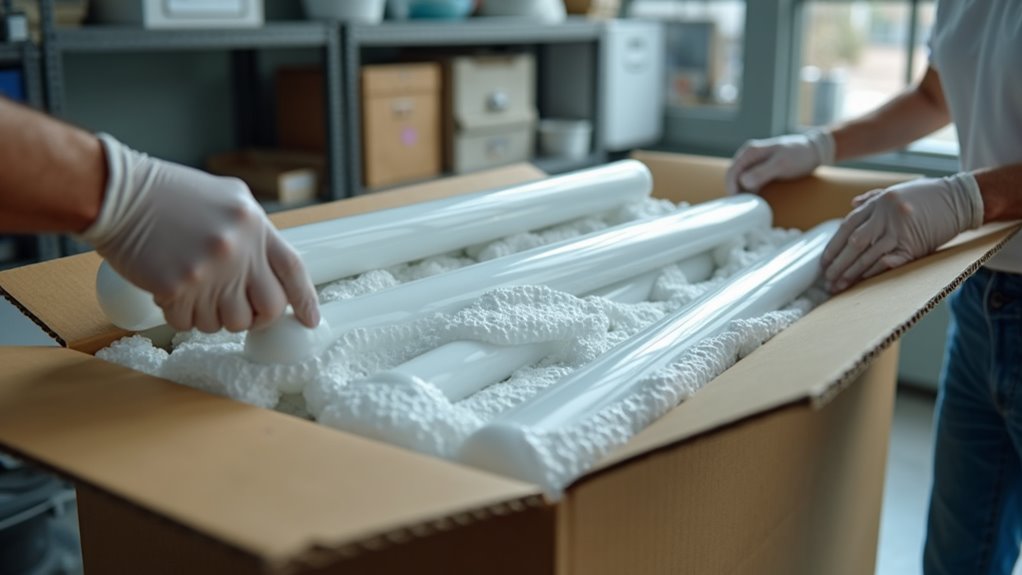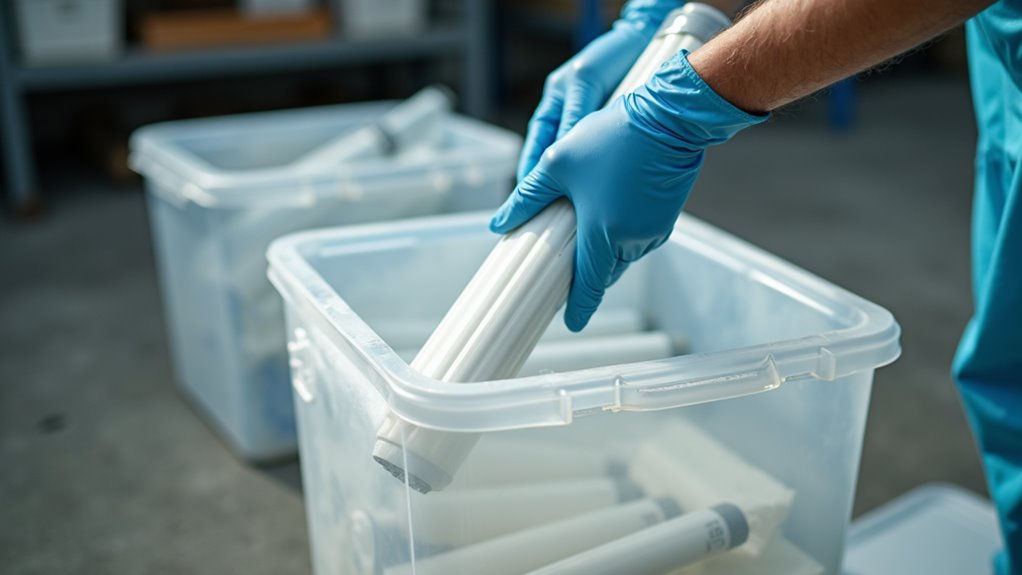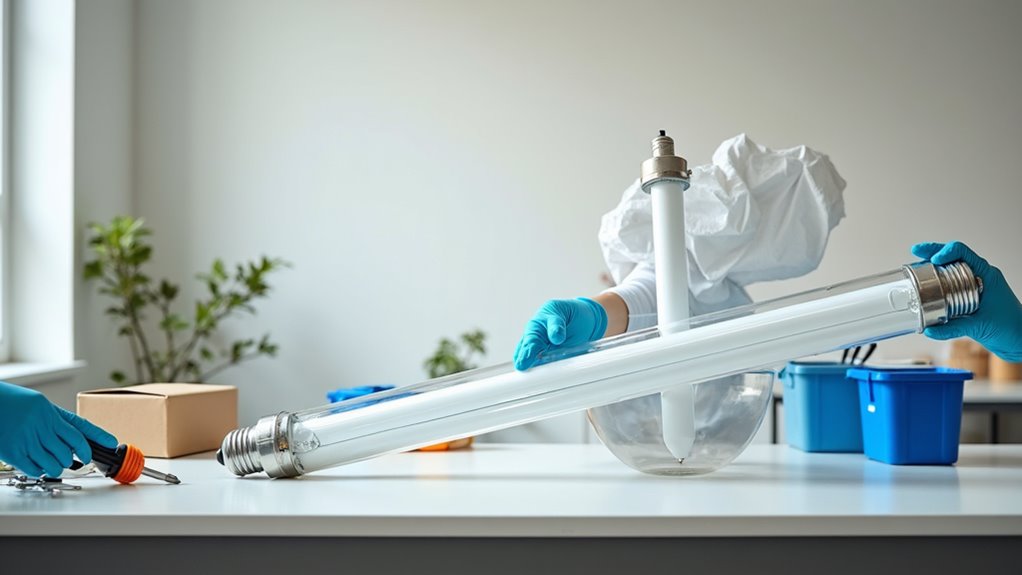Fluorescent light bulbs contain hazardous materials like mercury, necessitating careful handling. First, turn off the power and wear protective gear. Remove intact bulbs gently and store them securely in labeled containers. For recycling, utilize local programs or retailers. In case of breakage, evacuate the area and ventilate it. Collect shards with sticky tape and clean surfaces with damp towels. Dispose of cleanup materials responsibly, and locate hazardous waste collection sites for safe disposal. More detailed steps await further exploration.
Key Takeaways
- Always turn off the power supply and test for electricity before handling fluorescent bulbs to ensure safety.
- Wear safety goggles and gloves to protect against mercury exposure during removal and cleanup.
- Carefully remove the bulb using gentle rotations, and store it in sturdy, labeled containers marked as “Universal Waste Lamps.”
- For broken bulbs, ventilate the area, avoid using a vacuum, and use sticky tape to collect fragments.
- Locate and utilize local recycling programs or hazardous waste collection sites for proper disposal of old bulbs.
Understand the Hazards of Fluorescent Bulbs

Fluorescent light bulbs, while efficient and widely used, pose several hazards due to their mercury content and potential for UV radiation emission. Each bulb contains mercury, a toxic heavy metal essential for producing UV light, yet it becomes dangerous upon breakage, releasing mercury vapor and dust into the environment. Recycling helps mitigate these risks by allowing for safe disposal and reducing the chances of mercury exposure.
Mercury exposure is a significant concern, as it is a neurotoxin that can adversely affect the brain, kidneys, liver, and nervous system, particularly in vulnerable populations such as infants and developing fetuses. Exposure, even at low levels, has been linked to neurological symptoms, including insomnia and headaches. Furthermore, improper disposal of fluorescent bulbs can lead to mercury leaching into soil and water, posing further environmental hazards.
Additionally, certain fluorescent lamps emit UV radiation, which can result in skin damage for sensitive individuals if proximity and exposure duration exceed safe limits.
Safely Handle and Remove Intact Bulbs

To safely handle and remove intact fluorescent light bulbs, one must follow a systematic approach that minimizes risks associated with electrical hazards and potential injury.
First, ensure the power supply to the fixture is turned off and verify with a non-contact voltage tester. Proper gear, including safety goggles and gloves, should be worn to protect against accidents.
Ensure power is off and verify with a non-contact voltage tester; wear safety goggles and gloves for protection.
Remove the light cover carefully, depending on its type, and then detach the bulb with gentle rotations to ensure alignment with the fixture slots.
Once removed, handle the bulb carefully by the base or tube to prevent breakage. For bulb storage, placing the bulb back in its original packaging or wrapping it protects it during transport, adhering to best practices for fixture safety.
Properly Store Old Bulbs

Proper storage of old fluorescent bulbs is essential to ensure safety and environmental compliance.
Utilizing original bulb packaging is recommended; however, sturdy cardboard boxes or specialized containers can be used when unavailable. Containers must be capable of preventing breakage and containing leaks.
Bulbs should be stored horizontally and packed snugly to minimize movement. Overfilling is to be avoided by using multiple smaller containers for ease of handling.
Clearly label and securely seal containers with strong tape to denote fragile contents, marking them as “Universal Waste Lamps”.
It is also crucial to store the containers in a dry, cool area while ensuring they are weatherproof. Following these storage tips safeguards against breakage and mercury vapor release.
Explore Fluorescent Bulb Recycling Options

While handling spent fluorescent bulbs, it is essential to explore recycling options to mitigate environmental hazards. Numerous recycling programs exist to properly manage various bulb types, particularly due to the hazardous mercury they contain.
Many retailers offer free drop-off solutions for Compact Fluorescent Lamps (CFLs), but it is advisable to confirm participation before visiting. Municipalities often run year-round recycling initiatives, especially during Household Hazardous Waste collection events.
For remote locations, mail-in recycling kits are available, providing a convenient solution. Businesses have specific obligations under hazardous waste regulations and should consult commercial lamp recyclers for bulk disposal.
Recognize Procedures for a Broken Bulb

When a fluorescent light bulb breaks, immediate safety precautions must be initiated to protect individuals and the environment from exposure to mercury.
A systematic approach for cleanup should be employed, followed by proper disposal methods to ensure all remnants are contained and disposed of safely.
Understanding these procedures is essential for minimizing health risks and adhering to regulatory requirements.
Immediate Safety Precautions
In the event of a broken fluorescent light bulb, immediate safety precautions are crucial to mitigate potential health risks associated with mercury exposure. Proper actions are necessary to prevent contamination and address vulnerabilities, particularly for sensitive individuals such as children and pregnant women.
- Evacuate all people and pets from the area immediately to avoid exposure to harmful mercury vapor.
- Ventilate the room by opening windows and doors and allowing fresh air to circulate for at least 15 minutes.
- Do not attempt to clean up the breakage with a vacuum or broom, as these methods can spread mercury dust and vapor.
These steps are essential for ensuring safety before proceeding to cleanup procedures.
Cleanup Procedures Explained
Effective cleanup procedures following a broken fluorescent light bulb are essential to safely manage the hazardous materials involved, especially mercury.
First, gather necessary cleanup materials, including disposable gloves, stiff paper or cardboard, sticky tape, damp paper towels, and a sealable container for debris.
For hard surfaces, scoop larger glass pieces with cardboard, using tape for smaller shards.
On carpets, pick up larger fragments with gloved hands and use tape for smaller remnants.
Ensure all cleanup materials are disposed of in the sealable container.
Avoid using a broom or vacuum during initial cleanup to prevent spreading mercury.
Finally, wash hands thoroughly and ventilate the area to minimize any potential residual hazard.
Proper Disposal Methods
Although proper disposal methods for broken fluorescent light bulbs may seem straightforward, adhering to specific protocols is crucial for minimizing health risks associated with mercury exposure.
To ensure bulb safety and limit environmental impact, follow these essential steps:
- Evacuate the area: Keep people and pets away from the breakage site.
- Gather cleanup materials: Use stiff paper, sticky tape, damp towels, and a sealable container.
- Dispose of contamination: Place debris in a sealed container, label it, and follow local disposal regulations.
Follow Safe Cleanup Steps for Broken Bulbs

When a fluorescent light bulb breaks, immediate and careful action is essential for safe cleanup.
First, evacuate all individuals and pets from the area and ventilate the space by opening windows and doors for 5-15 minutes. It is critical to turn off HVAC systems to minimize mercury exposure.
Gather cleanup supplies, including stiff paper, damp paper towels, and a sealable container.
Wearing disposable gloves, carefully collect glass shards using stiff paper without using a broom or vacuum cleaner initially. For carpets, follow similar precautions, only vacuuming after visible debris has been removed.
After cleanup, securely dispose of all materials in an outdoor trash container, emphasizing mercury awareness and promoting proper bulb maintenance during future usage to mitigate risks.
Utilize Sticky Tape for Small Fragments

After larger fragments have been cleared, utilizing sticky tape becomes an effective approach for collecting small glass shards and any residual powder. This method employs specific tape application techniques to ensure comprehensive area coverage. It is vital to choose the right type of tape and assess its effectiveness during the cleanup process.
- Select a wide, sticky tape (duct, packing, or masking) for optimal fragment collection.
- Firmly press the tape onto the affected surface, covering all areas—even those that appear clean.
- Patting the tape helps lift fine particles, ensuring no fragments are left behind.
Using these techniques will facilitate the safe gathering of potentially hazardous materials, promoting a thorough tape effectiveness evaluation following the cleanup.
Wipe the Area and Dispose of Cleanup Materials

Cleaning the area following a fluorescent bulb breakage is essential to mitigate potential hazards. Proper wipe techniques involve using damp paper towels or disposable wet wipes to clean contaminated surfaces, starting from the edges and moving inward.
All used materials must be placed directly into disposal containers, such as sealable plastic bags or glass jars with metal lids, to prevent mercury vapor exposure. Footwear that contacted the mercury powder should also be wiped, and the wipes disposed of in the sealed containers.
Contaminated clothing or bedding must be discarded without laundering, as washing can lead to further contamination. All cleanup materials should be promptly taken outdoors and placed in a secure trash container, adhering to local disposal regulations.
Clearly Label Sealed Containers

Clearly labeling sealed containers containing old fluorescent light bulbs is essential for both regulatory compliance and safety. Adhering to labeling requirements helps in hazard communication and ensures that proper handling procedures are followed.
Properly labeled containers play a vital role in minimizing risks associated with fluorescent waste.
- Use terms like “Universal Waste Lamp(s)” and include the accumulation start date.
- Clearly indicate that the containers contain fragile items and label any broken bulbs as “Universal Waste – broken lamp.”
- Ensure labels are visible and contain emergency contact information for potential spills or exposure.
Such meticulous labeling aids in regulatory compliance and enhances safety for all personnel involved in handling these hazardous materials.
Locate Household Hazardous Waste Collection Sites

The proper disposal of old fluorescent light bulbs requires identifying appropriate household hazardous waste (HHW) collection sites.
Proper disposal of old fluorescent light bulbs involves finding suitable household hazardous waste (HHW) collection sites.
Waste management strategies emphasize the importance of utilizing resources such as Earth911 or Search.Recycle.Com, which allow users to input their zip code and locate sites that accept fluorescent bulbs.
The Environmental Protection Agency (EPA) website provides links to local HHW programs. State environmental agency websites often feature HHW facility locators.
Additionally, contacting local environmental agencies can yield information on permanent or periodic HHW collection events. Various facility types include permanent sites, temporary events, and curbside collection programs.
It is essential for households to verify operating hours, accepted materials, and potential fees associated with these recycling initiatives to ensure effective disposal.



Bài viết cùng chủ đề:
How Do Smart Light Bulbs Work?
Top 3 2700 Kelvin LED Light Bulbs for Warm Lighting
10 Best Bright Outdoor LED Light Bulbs for 2025
How to Pack Light Bulbs for Moving in 5 Easy Steps
The 7 Most Energy-Efficient LED Light Bulbs for 2025
Top 5 Spare Christmas Tree Light Bulbs for a Bright Holiday